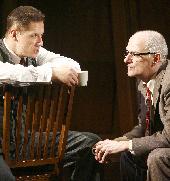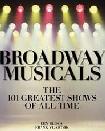SITE GUIDE
SEARCH
REVIEWS
FEATURES
NEWS
Etcetera and
Short Term Listings
LISTINGS
Broadway
Off-Broadway
NYC Restaurants
BOOKS and CDs
OTHER PLACES
Berkshires
London
California
New Jersey
DC
Philadelphia
Elsewhere
QUOTES
TKTS
PLAYWRIGHTS' ALBUMS
LETTERS TO EDITOR
FILM
LINKS
MISCELLANEOUS
Free Updates
Masthead
Writing for Us
A CurtainUp Review
Bill W. and Dr. Bob
|
I’d heard what booze had done to my grandfather, seen what it’d done to my father. I vowed it would never happen to me— Bill Wilson I’ve tried everything including drinking with him. —Lois Wilson |

Robert Krakovski as Bill W. and Patrick Husted as Dr. Bob
(Photo: Carol Rosegg)
|
With each man given a few words to establish their respective backgrounds, Bill W. is seen as earnestly zealous. Dr. Bob is defined by his quick-witted honesty ("I was forced by Mother to attend church four times a week. I vowed that when I was free, I’d never darken the doors of a church again – a vow I’ve kept, religiously, for forty odd years"). Robert Krakovski (Bill Wilson) and Patrick Husted (Dr. Bob) portray the two dynamic and dedicated men who, in the midst of their battle with acute and debilitating alcoholism, formed a formidable and historic alliance to help others combat the same addiction.
Stephen Bergman, a novelist and playwright, and Janet Surrey, a clinical psychiatrist and author, have collaborated on a courageously blunt, uncompromisingly straight-forward docu-drama that chronicles the circuitous path that these men took to arrive at a practical method of dealing with a life-threatening condition. The result was Alcoholics Anonymous, the organization that continues to save the lives of millions of men and women.
Until mid-way into the 20th century, alcoholism was not considered a disease but rather a weakness of character. The first half of the play takes us from 1925 to 1955 and to many locations with dramatic episodes (some catastrophic) revealing each man’s battle with alcohol its effect on their professions, marriage and family life.
Yes, this is a message play, but the message is engrossingly deployed within the frame of some terse, often humorously embroidered scenes that include a number of significant supporting characters— notably Bill’s wife Lois (Rachel Harker) and Dr. Bob’s wife Anne (Kathleen Boyle). There are two additional actors, Marc Carver and Deanna Dunmyer, as various men and women who are approached and subsequently helped by Bob and Bill working as a team.
Most fascinating are the profound differences in Bill and Bob’s personalities and backgrounds. When we meet Bill, he is something of a dynamo, a Wall Street broker riding the highs and lows with reckless abandon; t hat is until the crash of 1929, when he is wiped out and unable to recoup or find a job. Fanatical in his desire "to be number one", Bill’s fall is as rapid as it is self-perpetuating. Krakovski presents a very honest and sad account of a man who, unable to be the provider, resorts to whoring and brawling.
Dr. Bob, on the other hand, is not only a secret drinker, but a surgeon who, when not drinking, turns into "a monster" and can’t function As Dr. Bob, Husted offers a portrait of a man embittered by his inability to cope and consumed by rage. His Dr. Bob is in turn terrifying and pathetic. Aware of his physical disintegration, the violent pains in his abdomen, and the increasingly catatonic fits that alarm his steadfastly supportive but gradually wearying wife, Dr. Bob is, at first, the more cynical and reluctant of the pair to envision a new approach.
As Bill’s wife Lois, Harker is exceedingly attractive, and her unwavering but very fine performance helps us see her as a proud and ultimately empowered team player. As Bob’s wife Anne, Doyle’s performance is much more poignant to observe, as her emotional reserves are put to the test, time after time. Among other well-defined characters, Dunmyer is especially good portraying Henrietta Sieberling, an Akron, Ohio matron cum sincere religious spiritualist, head of the Oxford Group House. Of Carver’s assorted characters, his most vivid is of a pathetic despairing lawyer drying out in a hospital bed who finds that resisting the attention and the good intentions of Bob and Bill is futile.
It is Bill’s revolutionary vision that the answer lies not in prayer, the most prevalent methodology at the time, but in getting drunks to talk to each other. The breakthrough occurs when Bill, after months of sobriety, finds himself at a bar. Instead of succumbing, he desperately initiates a meeting with Dr. Bob on May 12, 1935 which results in a 6-hour one on one in the lobby of the Mayflower Hotel in Akron, Ohio—historically speaking, the first AA meeting. It's a scene that amusingly shows the two men bait and befriend each other, but unites the key provocateurs on stage for the balance of the play.
While both men express their disdain for religion and their doubts about the benefits of spiritual guidance, their crusade for converts nevertheless takes on a decidedly religious aspect. However, that prayer ultimately became a part of AA’s Christian-based philosophy is only alluded to during the epilogue.
Under Rick Lombardo’s brisk and brawny direction, Bill W. and Dr. Bob moves along its predictable course with a surprisingly bright energy. Adding considerably to the volatile moods and fully visible at center stage is the piano playing by composer Ray Kennedy, who supplies a good dose of melodic underscoring and a medley of hit tunes from the era. Set designer Anita Fuchs provides an environment of slightly tilted wooden panels to possibly indicate the skewed vision of the inebriated. Not terribly subtle, but neither is the crisp repartee or the wonderful clash of those two titans of temperance.
|
Bill W. and Dr. Bob By Stephen Bergman and Janet Surrey Directed by Rick Lombardo Scenic Design: Anita Fuchs Costume Design: Jane Alois-Stein Lighting Design: Daniel Meeker Music Composed and Performed by Ray Kennedy Sound Design: Rick Lombardo Fight Choreographer: Ted Hewlett Running time: 2 hours including intermission New World Stages, Stage 2 at 340 West 50th Street 212/239-6200 Tuesdays through Fridays at 8 PM; Saturdays at 2 and 8 PM; and Sundays at 3 and 7 PM. Tickets: $66 From 2/16/07; opening 3/05/07- extended repeatedly, closing 5/04/14 Review by Simon Saltzman based on March 5th performance |

Easy-on-the budget super gift for yourself and your musical loving friends. Tons of gorgeous pictures.

Leonard Maltin's 2007 Movie Guide

At This Theater
Leonard Maltin's 2005 Movie Guide

 >
>

